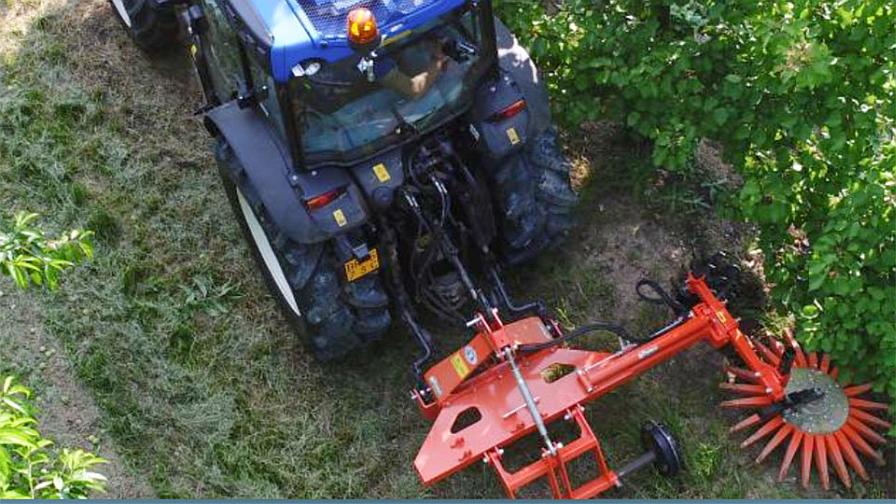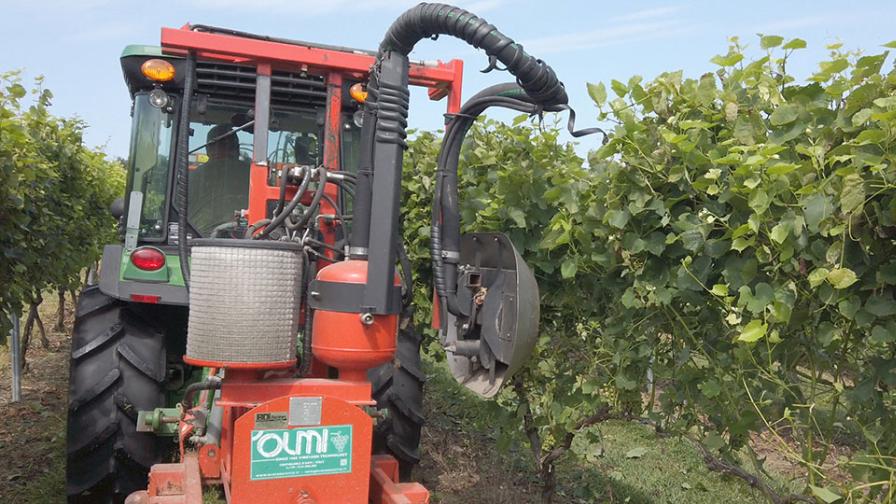Upgrades to Vineyard Equipment Means More Gains for Growers
Grape growers are increasingly implementing mechanization into their operations, according to Paul Licata, the President of BDi Machinery Sales in Macungie, PA. Forcing the issue, he says, are the two largest expenses for a vineyard operation — labor and chemicals.
“Mechanization is the future,” Licata told attendees of the Maryland Grape Growers Association annual conference. “Evaluating the current labor costs vs. equipment costs for your ROI can make the buying decision very simple.”
Expenses aside, the current lack of available labor has become impossible to ignore. “Someone can always pay more for something, but if you can’t get labor, even at a high cost, you can’t operate,” Licata says.
Meanwhile, the cost of chemicals has also dramatically increased. “A sprayer is critical to operations,” Licata says, “and the choice of the most efficient sprayer is important, with it using less chemical, less water, and saving time.”
CULTIVATION AND CANOPY CARE
The easiest payback in moving to machines, according to Licata, starts with a hedger/trimmer, then to weed control and, in order, leaf removal, pruning, and pre-pruning. He provides updates on the following mechanical cultivation and canopy management technologies offered by BDi:
Hedger/trimmer: This technology has evolved rapidly because of labor and ROI considerations, Licata says. While implementing a hedger is typically a first step for most growers, it is one that requires foresight, he adds, because of the many possible configurations with single- and dual-sided machines. “It’s a conversation you have as you’re looking at implementation to find out what is your growing style, what is your trellis height, what is your canopy height, and those types of items, to make sure you have the correct machine,” Licata says.
Finger weeder cultivator: This machine highlights the movement away from spraying toward organic weed control. The new range of equipment results in fast mechanical weeding (up to 6 mph) and is composed of Bio-Disc, which breaks the ground near the plants, and Bio-Star rubber spokes, which come in different sizes and hardnesses for inter-row processing.
Traditional plow (for hilling up and down): Growers in cold-climate states, such as Maryland, Pennsylvania, and New York, often prefer to hill up in the fall — and later hill down in the spring — to prevent winter rot and other diseases. A plow that is attached to a sturdy beam can be reversed for either task thanks to a touch-arm actuator that allows the operator, when hilling down, to go interrow and hill the dirt back down as springtime approaches, Licata says.
Under-vine management tool carrier: Up to six tools can be attached to a single platform, starting with a disc and blade for root pruning. Other attachments include hoeing discs, a mulcher/mower, power harrow, and sucker remover. “This is hydraulicly controlled through activation movements. Having bamboo and/or pencil rod at each of your vines is important, so we’re not introducing any type of disease by contacting the vine directly,” Licata says.
Power harrow: Whereas finger weeders cater to soil that is less dense, with not a lot of rock or clay compaction, the power harrow is introduced in dense soils that have compaction, clay, and in some places many rocks. An electrohydraulic control box allows the operator to retract fully, for instance, at the end of a row. “In the event you have young vines that you don’t want to cultivate around or have any contact with, you can also use the electrohydraulic control to move the machine out of the way so it’s not cultivating in a particular area,” Licata says.
Herbicide boom weed sprayer: The machine’s boom and cone assembly can skirt about an inch above the soil, allowing for targeted weed-control sprays and drift prevention. “As many try to move away from (herbicide applications), there are some areas where it’s needed, and alternative solutions are just not able to be implemented for a number of different reasons,” Licata says. “The boom and cone allows you to make sure you apply whatever chemical you’re applying very specifically, very targeted, while making sure there is no type of drift or moving or getting close to a vine area that you don’t want (sprayed).”
Leaf puller: Although available for the tool carrier, stand-alone double-barrel machines are available for leaf removal. The machine removes leaves from the grape zone, increasing maturation and aeration, while reducing the amount of chemicals sprayed.
Air impulse deleafer: Licata calls this machine, which can be implemented multiple times during the growing season, the “pinnacle” of leaf-removal technology. Air-powered through a compressor to multi-diffusers that are rotating, the pneumatic machine shatters leaves to remove from the canopy as opposed to previous technologies that pull the leaves. While trials indicate traditional leaf pullers remove 50% to 60% of control, the air impulse deleafer removes 100% of control, Licata says.
Battery-powered pruner and tying machine: BDi customers indicate that implementation of these products has cut labor forces in half while doubling productivity of existing labor forces, Licata says. Pruner heads come in multiple sizes, including the standard 1½ inches and up to 2 inches. The same battery and charger can be used for multiple tools.
Pneumatic pruners and sanitizers: Some growers continue to use air-powered pruners, Licata says. The option of an accompanying sanitizer helps to control disease from moving from one area to another. “You can not only be sanitizing each cut but also sanitizing the shears in-between cuts,” Licata says.
Spader: Although this machine is traditional, users are seeking high-quality steel and bearings for better longevity toward the treatment of middle row compaction, Licata says. “They’re looking to loosen their plow pan and be able to get drainage in the middle rows,” he says. “In a conversation with one tried and true grower who uses a spader every year, he goes down his rows at the end of the year in late November or December and uses his spader to open up large chunks. He leaves that for the wintertime and comes back in the spring, tills it, and then seeds it.”
Stone and rock crusher: In addition to grinding up boulders up to 6 inches below the surface, this machine also acts as a stump grinder. “There are areas that you can clear, but getting that down to plantable ground can certainly be very cost challenging as you’re looking at removal vs. implementation of a tool that can prep the land and then have it ready for planting,” Licata says. “It’s a very heavy-duty machine.”
Shredder/mower: Improvements in quality of steel as well as minimized maintenance and repairs highlight an otherwise traditional machine. Also, the option of side-shifting, rather than relying on a standard fixed rear, allows operators to get as close to the vine area as necessary, Licata says.
Disc harrow: Growers plagued by tractor grooves and track compaction can turn to this tool for ground leveling as well as extreme hilling up. “You can use a traditional hoeing plow, but here’s an alternative depending on your middle rows and your management of that, which is done on every other year or can be done for hilling up during those cold-weather challenges you might be incurring,” Licata says.
Vine auger: For growers looking to rejuvenate aged vineyards, vine augers are more efficient than using chains to remove vines, Licata says. “A lot of times you see damage happening, not getting all of the root masses out, leaving disease,” he says. “This implementation of a vine auger works extremely well in removing old-age vines and having the vineyard ready for replanting.”
Stone and sod burier: These machines are designed for working in stony soils and for preparing sowed middles for replanting. This tillage machine does primary, secondary, and final tillage in one pass. It is possible to buy the reverse rotation of a standard tiller that picks up stones and/or sod clumps and deposits them at the bottom of the furrow while leaving the fine soil on top as the mesh cage roller firms the finished seedbed.
Small-acreage sprayers: Because not every grower has a tractor, there is a call for engine-powered sprayers for vineyards between 1 and 5 acres. “You can put those on a Gator, or an ATV, or even on a golf cart and still be able to get 30 to 35 gallons of capacity and take care of your spraying with a real easy pull-start and do a half a row at a time,” Licata says.
Backpack atomizer: Growers are using these traditional pieces of equipment for small acreage vineyard canopy spraying, as well as mist sprayers (90-micron units) in the fight against the invasive spotted lanternfly. “They’re spraying their tree lines with them,” Licata says. “It has both vertical and horizontal spray of up to 50 feet, so it could be multi-purposed. Or for someone able to walk 1 to 3 acres, it’s 65 pounds.”
Three-point hitch sprayers: Larger sprayers, such as low-volume atomizer sprayers, air-blast sprayers, and high-volume sprayers, are available in tank sizes between 80 and 165 gallons.
Trailed sprayers: Pull-behind machines, with power take-off (PTO) for the fans, are available in tanks between 200 and 500 gallons.
Sprayheads: How are the chemicals being applied to canopies? Sprayhead technologies include vertical boom/curtain sprayers, high-pressure/air-assisted sprayers, recycling sprayers, low-volume atomizers, electrostatic sprayers, and row cannons.
Sprayer components: Replacement costs vary among centrifugal, diaphragm, and piston pumps, which is vital for growers to realize as long-term investments such as sprayers age. Meanwhile, manual valves have been replaced by motor valves in tractor cabs with 12-volt cigarette lighters that can control those motor valves. Finally, with regard to pressure regulators, a grower should realize when selecting a sprayer “what is the pump that is powering it, how am I controlling it with my valves, and how do I adjust the pressure? Can I do it myself? Or do I have to have somebody come out and do it for me?” Licata says.













